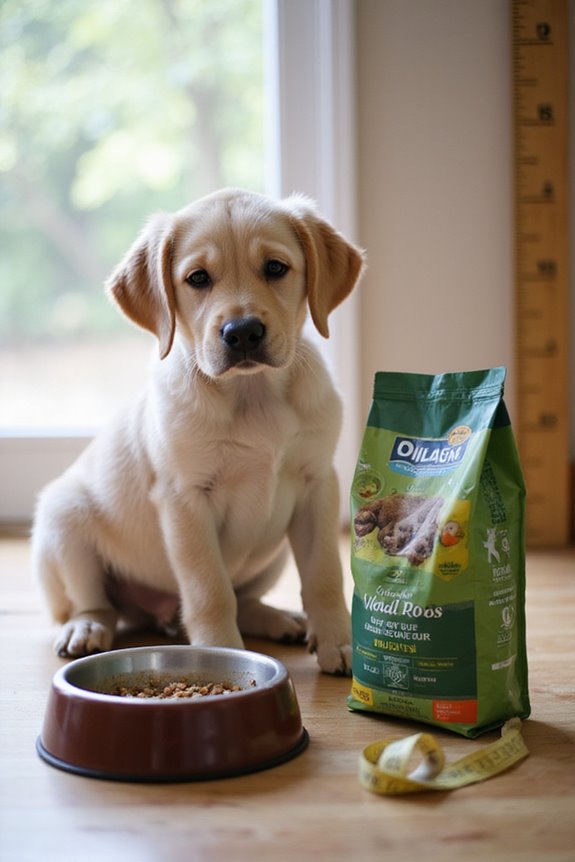The timing to switch from puppy to adult food depends on your dog’s breed size. Small breeds usually change between 9 to 10 months, medium breeds around 12 months, and large breeds may not be ready until 16 to 24 months. Signs of readiness include reaching approximately 80% of their adult size and stable appetite. A gradual change over 7 to 14 days is recommended to avoid gastrointestinal distress. Explore the specifics of each breed’s needs for a better understanding.
Key Takeaways
- Small breeds usually mature by 9 to 12 months, making the switch between 9 to 10 months ideal.
- Medium breeds typically change to adult food around 12 months when they reach 80% of adult size.
- Large and giant breeds may need to stay on puppy food until 16 to 24 months for proper growth.
- Gradual food transition over 7 to 14 days helps prevent gastrointestinal issues.
- Regular veterinary consultations ensure the timing and dietary needs are tailored to your puppy’s growth and health.
Understanding Your Puppy’s Growth Stages
Understanding your puppy’s growth stages is essential for providing the appropriate care and nutrition necessary for their development. During the neonatal stage (birth to 2 weeks), puppies rely entirely on their mother, as their nutritional needs are met through nursing. Their sensory development begins here, though sight and hearing remain underdeveloped. From 2 to 4 weeks, the changeover stage introduces initial weaning, soft food, and the emergence of baby teeth. As they enter the socialization stage (3 to 12 weeks), behavioral changes occur through social interaction with littermates and humans. Feeding schedules evolve to accommodate their growth milestones while ensuring their nutritional needs are met. By the time they reach 8 weeks, weaning completes, establishing a robust foundation for their future development.
Small Breed Dogs: Timing the Switch

As puppies progress through their early growth stages, it’s important to be attentive to when to change small breed dogs from puppy to adult food. Typically, small breeds reach puppy maturity around 9 to 12 months. Veterinarians recommend shifting to adult food between 9 to 10 months, although some may need the change as early as 7 months, depending on size.
Here are key indicators for timing the change:
- Achieving about 80% of adult size
- Monitoring feeding frequency and leftovers to gauge appetite
- Noticing changes in energy requirements as growth stabilizes
Gradually introducing adult food over 10 to 14 days helps ease gastrointestinal upset. Always consult your vet for personalized advice on your dog’s specific needs and readiness.
Medium Breed Dogs: Transitioning to Adult Food

When determining the best time to shift medium breed dogs from puppy to adult food, it’s essential to recognize their growth benchmarks and unique nutritional needs. Typically, medium breeds weigh between 20 and 60 pounds and reach physical maturity around 12 to 14 months. The ideal change occurs around the 12-month mark, as they should have achieved roughly 80% of their adult size.
To smoothly change:
- Begin mixing adult food with puppy food gradually over 7 to 10 days.
- Monitor for signs of digestive upset, such as stool consistency.
- Consider their activity level; more active dogs might need a delayed switch.
Each dog’s individual growth and health should guide the timing, with veterinary input being invaluable.
Large and Giant Breeds: Patience Is Key

Shifting from puppy to adult food for large and giant breeds requires careful attention to their extended growth timelines and unique nutritional needs. These breeds mature between 16 to 24 months, and some may not be ready until 24 months, based primarily on their individual growth patterns.
It’s essential to understand that they have specific nutrient requirements during this prolonged development. Puppy food designed for large breeds offers critical levels of calcium, phosphorous, and calories to support healthy bone and joint formation.
Transitioning too early to adult food can create nutritional deficits, increasing the risk of orthopedic issues. By patiently monitoring your dog’s growth and waiting until they reach about 80% of adult size, you can help guarantee ideal health and development.
Factors Influencing Transition Timing

Understanding the factors influencing the timing of a change from puppy to adult food is essential for ensuring your dog’s health and well-being. Key factors include:
- Growth Rate: Smaller breeds may change around 7 to 10 months, while medium breeds typically wait until 12 to 15 months.
- Activity Levels: As puppy energy needs stabilize and calorie requirements decrease, it’s a cue for change.
- Spay/Neuter Status: This can affect metabolism, often requiring an earlier switch to manage weight.
- Dietary Adaptation: A gradual mix of adult food over 10-14 days helps support digestive health.
- Body Condition Monitoring: Observing weight and appetite helps assess readiness for adult food.
Consulting with your veterinarian is vital in ensuring you make the right choice for your dog’s unique needs.
Health Considerations for Switching Food
Changing from puppy to adult food involves significant health considerations that can impact your dog’s overall well-being. Timing is essential; switching too early may hinder growth development, leading to potential deficiencies, while waiting too long increases obesity risk due to excess calories from puppy food.
Here are key considerations during this changeover:
- Gastrointestinal Distress: Sudden dietary changes can cause upset stomachs; introduce adult food gradually over 7-10 days to prevent issues.
- Growth and Bone Health: Guarantee careful timing, especially for larger breeds, to avoid joint problems later.
- Energy Needs: Adjust food based on your dog’s activity level; adult formulas maintain energy without excess calories.
Nutritional Differences Between Puppy and Adult Diets
When considering the shift to adult dog food, it’s vital to recognize the significant nutritional differences between puppy and adult diets. Puppy food requires at least 22.5% protein, providing important protein sources like chicken, beef, and fish to support rapid growth. In contrast, adult food contains about 18% protein, focusing on maintenance rather than development.
Additionally, puppies need a minimum of 8.5% fat to meet their higher calorie needs, while adult food has only 5.5%. This difference safeguards against excessive weight gain post-growth. Moreover, puppy diets contain elevated calcium and phosphorus for healthy bone development, alongside concentrated vitamins for immune support. Adult formulas shift focus to sustaining health, ensuring a balanced diet for a mature dog.
Best Practices for Transitioning to Adult Food
Shifting from puppy food to adult food is a significant step in ensuring your dog’s continued health and well-being. Here are some best practices to make this change smoother:
- Change Techniques: Start with a mixture of 12.5%-25% adult food combined with puppy food. Gradually increase the adult food ratio by approximately 10%-25% every few days over 5 to 14 days.
- Feeding Ratios: By day 3 to 5, aim for a 50%-60% adult food ratio, progressing to 75%-80% by days 7 to 9.
- Monitor Reactions: Observe for gastrointestinal upset; if symptoms occur, slow the change.
- Consistent Schedule: Maintain regular feeding times and frequencies to minimize stress.
Being patient and attentive to your dog’s needs is essential for a successful change.
Signs Your Puppy Is Ready for Adult Food
Knowing the right moment to introduce adult food into your puppy’s diet involves observing several key indicators of readiness. Here are the signs to watch for:
- Physical Growth: Your puppy is about 80% of their expected adult size, with a noticeable slowdown in growth rate.
- Behavioral Changes: Puppy behavior shifts from hyperactive to more stable energy levels, indicating maturity.
- Nutritional Needs: There’s less need for high-calorie puppy food as growth slows, making adult food more suitable for maintenance.
- Health Markers: Healthy stool, stable weight, and a shiny coat are indicators of proper nutrient intake.
- Feeding Habits: A reduced appetite for calorie-dense food suggests they’re ready for adult food.
Monitoring these signs will help guarantee a smooth progression for your beloved pup.
Consulting Your Veterinarian for Guidance
As you contemplate shifting your puppy from puppy food to adult food, it’s important to consult your veterinarian for tailored guidance. Veterinary recommendations are essential, as they offer individualized advice based on your puppy’s breed, size, and growth pattern. This personalized guidance helps inform the best timing for the shift.
Dietary evaluations by your veterinarian can prevent nutritional deficiencies or excesses that may arise from inappropriate timing. They can guide you through the gradual change process and monitor your puppy for any adverse reactions, ensuring a smooth changeover. Additionally, a vet can recommend specific food brands that cater to your puppy’s health needs, addressing any sensitivities while also evaluating their overall growth to maintain peak health during this critical phase.
Frequently Asked Questions
Can I Mix Puppy and Adult Food Together for a Transition?
Mixing puppy food with adult food feels like a gentle hug for my dog’s tummy. I’ve found that this gradual change helps ease any belly rumbles while ensuring my pup gets all the necessary nutrients.
What if My Puppy Refuses to Eat Adult Food?
I totally understand your frustration when your puppy refuses adult food. Try shift methods like mixing old and new foods gently, and remember, our furry friends often have strong food preferences that we need to respect.
Are There Specific Brands Recommended for Adult Dog Food?
Absolutely, I’ve discovered delightful, premium options like Royal Canin and grain-free choices from Blue Buffalo. Finding the perfect food is essential for your furry friend’s health, and I’m here to help you choose wisely!
Will My Puppy Grow Differently if I Switch Foods Too Early?
I’ve noticed that switching foods too early can really impact puppy development. During key growth stages, it’s essential they get the right nutrients to avoid future health issues. Pay close attention to their needs!
How Can I Tell if My Dog Is Overweight During the Transition?
I watch my pup closely, feeling for ribs beneath soft fur. If I notice that snug waistline disappearing, it’s time for careful weight management. A little extra love can keep our furry friend healthy, right?




